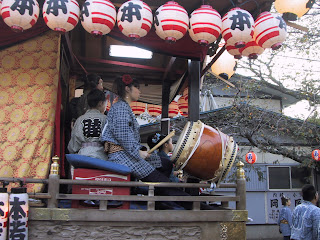decidedly local affairs. Tourists stick to the
big cities, and while the events are clearly
commercialized as all heck - hundreds of
street-front booths selling fried food and
souvenir stuff - the focus is decidedly local,
down to a neighborhood level.
Arrived in Sakura city on saturday around
3pm, which was the start time advertised.
Immediately I saw street stalls leading up
the main road away from the train station.
A few people were making their way up the
hill, so I followed.
20 minutes later, I was sure I had missed
all the fun. Street boths were folding up their
awnings, and cars were scooting down the road.
Then I heard some really loud drumming and
fireworks, and from down a smaller street I
saw a procession of 1 1/2 story high rolling carts
pulled by men and women in costume jackets
(Hanten).
Little did I know that this would start a
constant parade of these carts, and smaller,
carried-on-shoulders shrines that would last
well into the late evening.











Each shrine, carried or wheeled, is sponsored
by a local neighborhood or merchants association.
Or swim club, or school, or whatever.
As they roll or bounce along their routes, back and
forth, they often stop and pay their regards to
the businesses that sponsored them, or perhaps,
those they feel like addressing. The big carts
actually swing around on a central post to help
this.
Did I mention that they all roll on stout wood
wheels and axles? Most are steered with a small
wheel like a skid hand-truck, but some rely
solely on guys with big poles to lever them
around.
A continuous cheer that sound a bit like
A SAI! SAI! SUSKA! is kept up for hours.
Often a small cart holding iced canned tea
follows for frequent breaks.
The shrines, both big and small, make it up and
down some really steep hills. I got to help carry
one of the portable shrines (As in Yokohama,
bystanders can get drafted!) and they are HEAVY!
And you better move in sync with everyone else!
Being a bit too tall is no help either.
I finally gave up around 7pm. I had
run out of digital camera batteries,
35mm film, and spare cash.
But I bought some size 29(cm)
(size 12.5 Canadian) high black
Tabi sock-shoes Way Kewl!
When I got home, I found the whole festival
was being live-cast on the local comunity
TV channel- It went on until 10pm.
Wow!


















